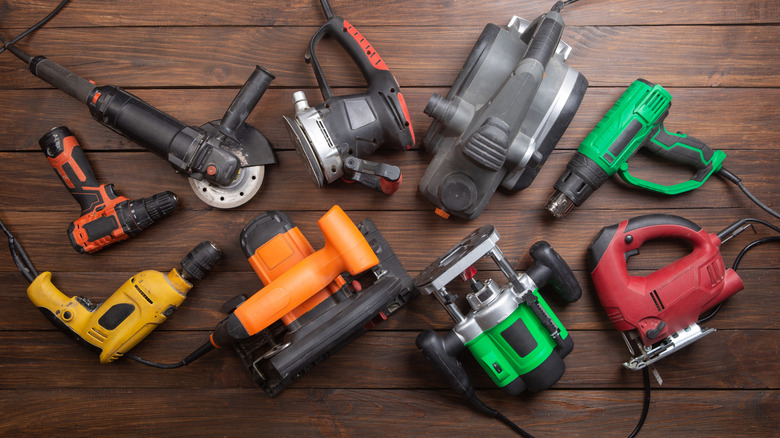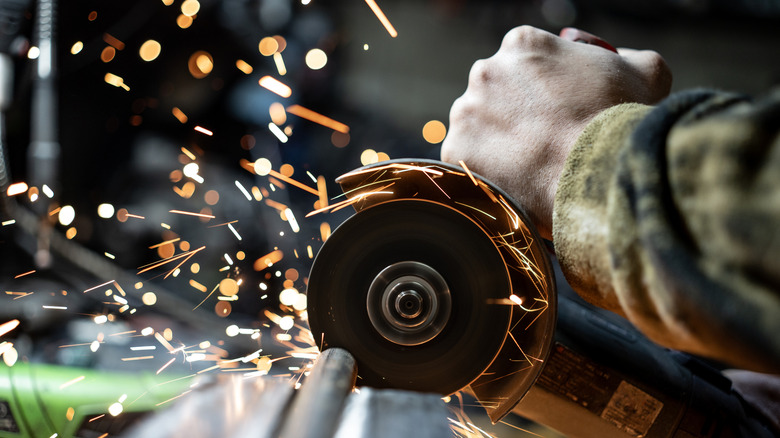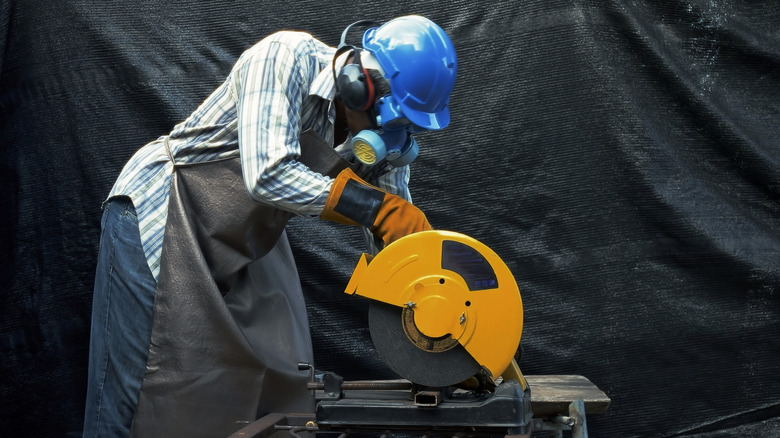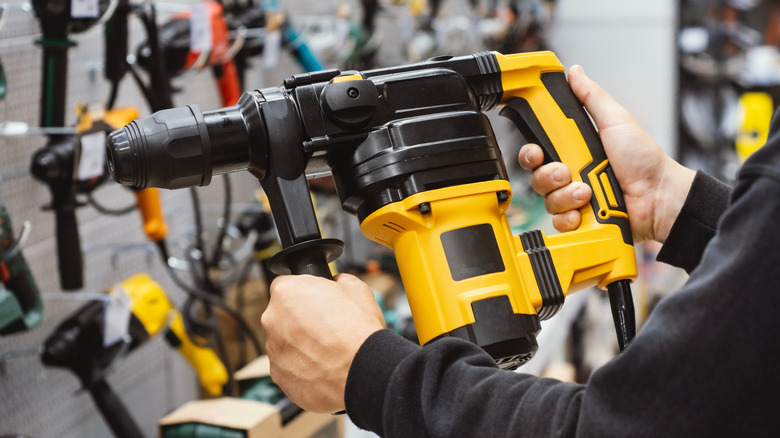5 Of The Most Difficult Power Tools For Beginners To Learn How To Use
Power tools have a way of humbling even the most confident hands (many of which I've worked with). In a concrete-manufacturing fleet workshop, they weren't shiny hobby toys that we had just for the sake of it, but rather the daily bread of keeping mixers, trailers, and heavy haulers alive. Most of the technicians and mechanics I supervised fancied the big jobs — tearing down wheel loaders, servicing booms, engine rebuilds and overhauls.
And while working with heavy-iron mechanics was fun, I couldn't stress enough that the real danger was not in those headline fixes, but in treating power tools like harmless shortcuts. I've seen new hires arrive on Monday, sparkling clean overalls and boots, only to leave on Friday with calluses, burn marks, and a painful lesson that even the best power tools don't forgive hesitation (or sometimes nervousness).
The problem is that most beginners think power tools are all about strength. When they see a rotary hammer or impact wrench, their heads go "squeeze it tighter." In reality, it's the opposite, and you can only be safe by using every tool with finesse and respect. After all, a grinder disc doesn't care about your biceps and might come after your arm if you handle it wrong.
There's also overconfidence. I've seen rookies make fun of the veterans for using torque sticks and chalking their rebar cuts. They skip the basics, and shortly after, they've stripped a hub stud or had a lucky miss with a cut-off saw.
The angle grinder
Nothing earns more scars at the workshop than the angle grinder. For fleets that include concrete trucks, dumpers, and loaders, grinders are indispensable, helping clean corroded surfaces, cut frozen bolts and nuts, smooth welds, and even trim steel brackets when replacement components don't fit perfectly. But it's also one tool that, in my experience, makes grown men flinch by simply spinning up.
Most beginners make the mistake of thinking "disc equals safe." Steel cutting discs are thin, brittle, and only rated for one force direction. If you tilt it wrong or wedge it in a cut, it could shatter, and that's bad news for the person working it. In fact, according to data from the Royal Society for the Prevention of Accidents' Accident Surveillance Systems, angle grinders ranked third among the most dangerous tools, with upwards of 5,000 injuries reported annually. The risk doubles in a heavy-equipment bay where sparks land on coveralls drenched in oil.
I once had to pull a trainee off a grinding job after he ignored the disc wear line, with the disk having shrunk to a size below what is deemed safe. Well, it did explode and thankfully not into his arm, but into a nearby wall. You should have seen his face. Since then, we instilled in every new hire the following lessons: wear a full-face shield, not just goggles, clamp your work, and check your discs regularly to ensure you're still within a safe diameter.
Impact wrench
Nothing is more satisfying than the rat-a-tat blast of torque from an impact wrench to free a seized lug nut on a truck, and nothing does it faster. For beginners, however, it can be a trap. Most believe it to be merely a quicker socket wrench until they snap a stud or strip threads.
Depending on the spec, each wheel stud on a truck hub can take just about 600 Nm of torque. A 0.5-inch pneumatic impact wrench from a brand like Kobalt can deliver upwards of 1,355 Nm of torque in short bursts, which makes it easy to overtighten if you're not experienced. During my time in fleet, I witnessed tire-fitting apprentices rattle down all lugs in less than a minute and call it done, unaware that half of the lugs were overtightened and the other half loose because the wheel hadn't seated. That mistake could lead to studs shearing — especially on the road — potentially leading to wheel loss, which can be catastrophic to say the least.
And it's not just about wheel safety either. Research on railway maintenance workers who often had to use impact wrenches revealed that their chances of reporting hand and wrist pain were 1.38 times higher than those of their colleagues who did not, suggesting a danger of long-term vibration. That's why my golden rule at the workshop has always been simple: impact to remove wheel nuts, hand-tighten to seat the wheel, and seal the deal with a calibrated torque wrench.
Table chop saw
In a construction-linked fleet, we used a heavy 14-inch cold-cut saw, often to slice rebars, steel pipes, and sometimes cross-sections of frames. By first impressions, the tool looks pretty straightforward — lower the blade and let the sparks fly, right? Turns out it's one of the most unforgiving, and data from the Consumer Product Safety Commission shows this, with 4,000 Americans reportedly suffering amputations every year from table saws, and that's not counting the lesser injuries, which are believed to number over 30,000. Though carpentry accounts for the majority of those figures, the hazards are equally the same even in metalwork.
I remember one incident where a junior mechanic tried to cut rebar without clamping it, like it was something optional. The bar pinched and snapped up, sending it sideways with enough force to dent a nearby workbench. He would have lost fingers instantly if his hand had been in line. And in this case, the rebound is rougher with steel, unlike wood, and the blade is even less forgiving.
Experienced technicians I worked with never rushed a chop saw. They never leaned their bodies over the cutting path, always used appropriate cut-off wheels (in this case, rated for steel), and most importantly, they always double-checked the clamp's tightness, as is standard practice. I made sure to emphasize these in our workshop table saw SOP, and often stop rookies mid-cut to adjust their stance. And in doing so, nobody ever lost fingers on my watch, thankfully.
Chainsaw
When you hear of a chainsaw, you'll probably think forestry right away, not a concrete fleet shop. But well, storms don't come knocking, and access roads to quarry yards are no exception to fallen trees, and it's during such instances that the chainsaw has to come out and save the day. For beginners (and even myself), there's nothing more intimidating than the raw, violent energy coming from this power tool. And that's with good reason, considering chainsaws account for over 36,000 injuries, according to the Centers for Disease Control and Prevention (CDC), with kickback often cited as the most common cause.
How does this happen? When the chain's upper quadrant unexpectedly comes into contact with metal or even wood, it kicks back, sending the bar hurtling back toward the operator. I once got called out of the office by one of our senior technicians after he witnessed an accident. Turns out the operator was trying to power through a knotted log by aiming the saw's tip into it. Fortunately, his helmet took the blow as the bar swung upward, and the chain gripped. It took him longer to regain his confidence than it took to fix his equipment, no kidding.
For beginners, the real challenge isn't starting the saw but rather controlling it. Chainsaws quickly wear out the back and shoulders. When the fatigue hits, beginners tend to drop their guard, loosen their grip, or let the bar sink too low, and that's when accidents happen.
Rotary hammer
It's safe to say that concrete is tougher than steel in the sense that it punishes impatience. Enter the rotary hammer. These drills come in handy in a fleet shop tied to manufacturing plants, mostly for floor mounts, anchor bolts, or fixing cracked bays. Most beginners like to think they're just "big drills," not knowing there's a steep learning curve when it comes to operating rotary hammers. Too much force burns out bits, too little hinders progress, and misusing power tools in this way is one of the most common workshop mistakes.
In my first workshop safety training session, our instructor showed us a CCTV video of a young technician drilling into a hardened slab to mount a car wash station at his former job. Believing that pressure equated to progress, the lad threw all of his weight onto the bit. You guessed it — the bit jammed in the hole, heat built up fast, and the shaft finally snapped. The broken carbide drill ricocheted off the slab with enough force to make everyone else in the bay step back. Rotary hammers require direction, not wrestling, a lesson he learned the hard way.
The cost of drill bits alone can also add up. Carbide bits for heavy hammers can cost anywhere from $30 to $50 each. So, if you break three in a week, you'll have burned through a day's budget. Even worse, if the drilling is done incorrectly, the concrete may spall and develop bigger fissures.





